In 2018 my friend Hugh called to offer me his beehive and beekeeping gear. He was moving back to New Orleans. As a longtime pollinator advocate and founder of San Antonio’s Monarch Butterfly and Pollinator Festival, I was a good candidate for inheriting his hives.
“Uh…OK,” I said.
For the next five years, I considered myself a hobbyist beekeeper. I took classes, read bee-centric blogs, books and websites, listened to beekeeping podcasts, and sought out local experts. Cecile Parrish, a master beekeeper and queen breeder in my hometown of San Antonio, became my mentor.
Multiple times, I moved the hive, experienced swarms, requeened and harvested honey. I lost bees to varroa mites, wax moths, extreme summer heat and Storm Uri. During brutal Texas summers, I fed “the girls” sugar syrup and pollen patties.
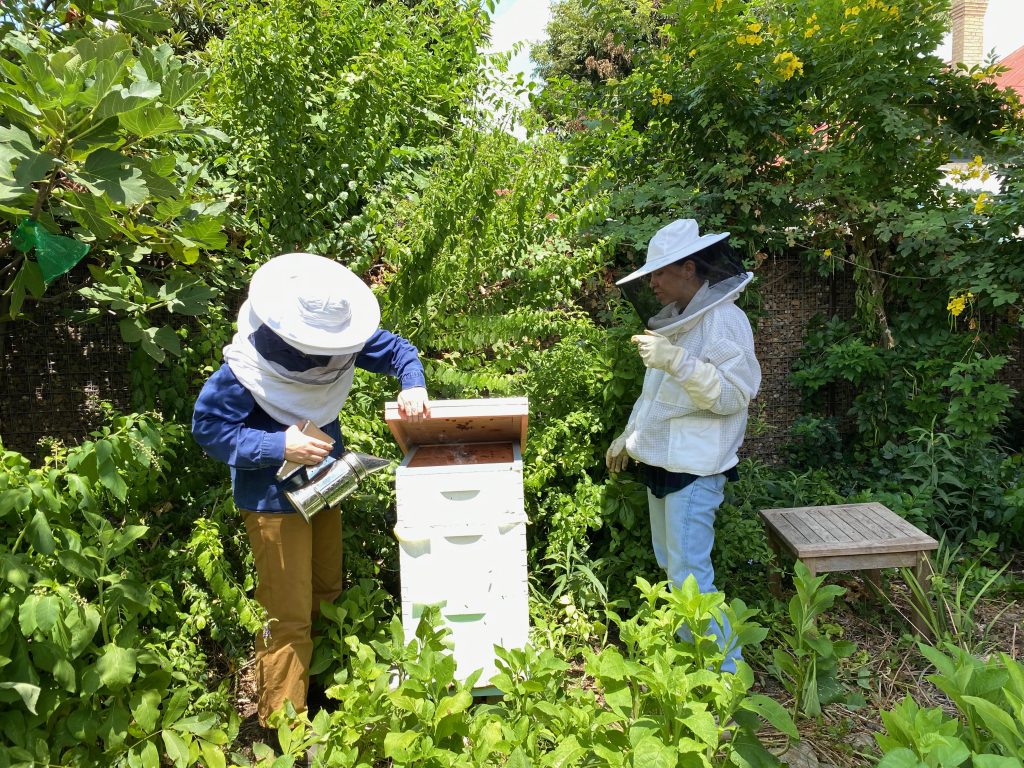
Hive checks with my bee friends during COVID were fun, gratifying and an escape from the loneliness of the pandemic. –Photo by Monika Maeckle
Mistakes and hubris defined my beekeeping education–I was stung hundreds of times. After reading a blogpost about how “real beekeepers” didn’t wear gloves when they checked their hives, I thought that made sense and tried it. Twenty-four stings later, my hands were so swollen I couldn’t type or work for three days.
I learned much from Cecile and these amazing insects, so different from monarch butterflies, which I have studied intensely. Their democratic matriarchy, led by a queen, provides ecosystem services that make much of our food possible. Did you know bees have their own dances and are capable of doing math?
For almost two decades, we’ve heard these bewitching insects were suffering from a mysterious malady called colony collapse disorder (CCD). First described in 2006, the affliction caused bees to literally disappear, decimating 30 – 90% of beehives in the United States, with no bee corpses left behind. Its cause? Almost 20 years later, we still don’t know for sure.
CCD focused attention and energy on bees and beekeeping, making Apis mellifera, the European honey bee, an insect celebrity. Calls to “save the bees” rang far and wide, appealing to a new generation of naturalists and beekeepers. The state of Texas even instigated an incentive program in 2012 that rewarded beekeepers with tax breaks for establishing beehives on rural lands.
Not long after I took up beekeeping, the New York Times Magazine featured a cover story showing an illustration of a bee with its head exploding in an atomic-bomb type cloud. The headline: “The Insect Apocalypse is Here.” The 7,400-word report chronicled the massive demise of insects in general, how we no longer remove scads of dead bugs from our windshields or swallow them while riding our bikes in the summer, as occurred in previous decades. The chorus to “save the bees” grew even louder and made my beekeeping endeavor feel worthy and admirable.
But was it?
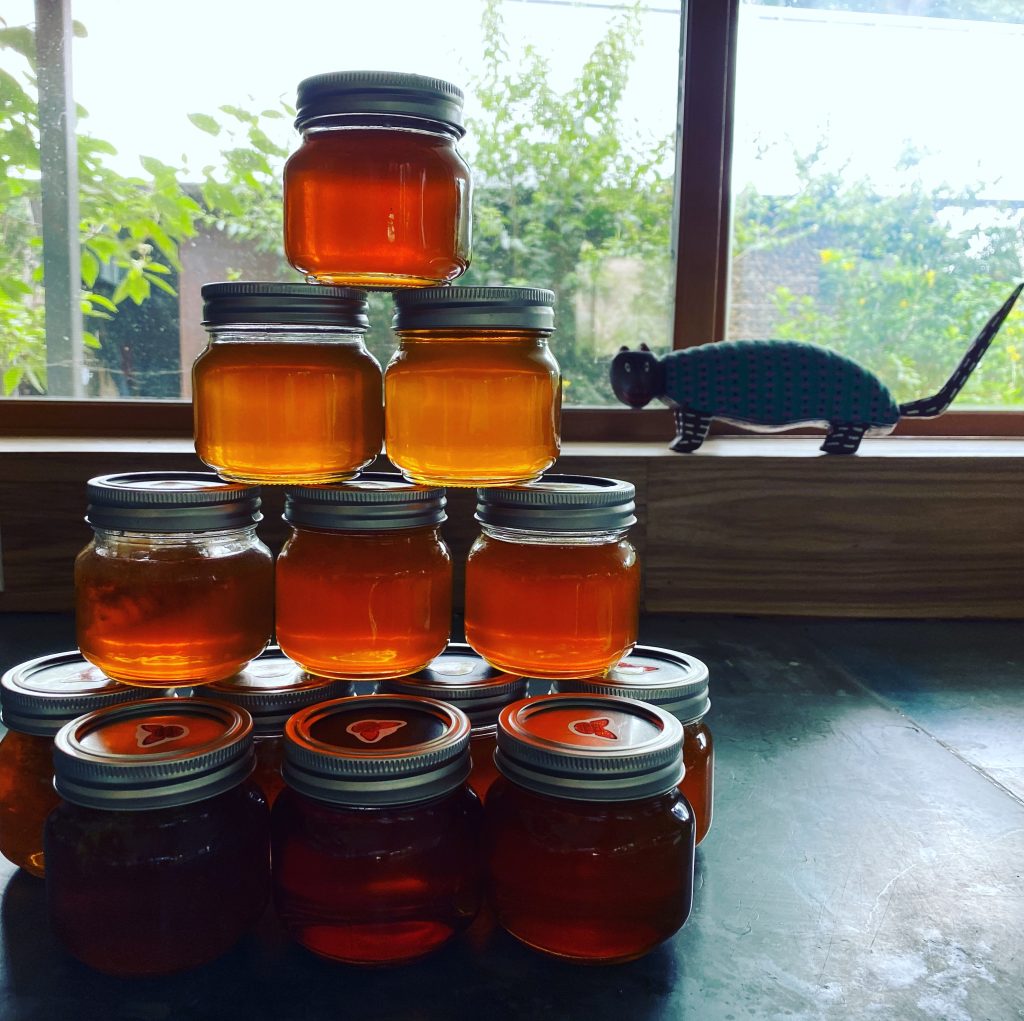
The cache of one’s own artisanal honey is undeniably appealing. –Photo by Monika Maeckle
The bees were enchanting, and the more I learned about them the more I began to question my hobby.
Every time I checked the hive and ripped open the carefully crafted propolis–a magical combo of wax, minerals and honey that seals the hive and protects it from predators–I felt like I was breaking and entering. Harvesting honey seemed arrogant, selfish and destructive. Honey bees fly an estimated 50,000 miles and tap about two million flowers to make 16 ounces of honey. I was stealing their produce so I could call it my own.
And what about the other bees–the bumble bees, the sweat bees, the carpenter bees, the leafcutter bees? European honeybees aren’t even from here. My beekeeping hobby was introducing 50,000 non native insects into a landscape with limited resources to compete with the locals for nectar and pollen.
By 2022, the number of Texas beekeeping operations numbered 8,939–up from 1,851 when the “bee bill” launched. The policy to incentivize landowners with property tax cuts if they hosted a minimal number of bee hives had been wildly successful in Texas, a state that funds its education system by taxing landowners’ real estate. The number of beekeepers in the Lone Star State now totalled more than the bottom 21 states combined. Also newsworthy: an estimated 80% of these newbie beekeepers quit within the first two years.
The swarm of novice beekeepers alarmed some in the beekeeping community, especially in urban areas where less nectar and pollen are available. A lack of natural resources can lead to unusual and questionable strains of honey, like the Big Red Honey experienced by my friend Liz Rendon.
She and a beekeeper friend were flummoxed when they checked the hive in the side yard of the historic building she occupies with her husband Al in San Antonio’s Southtown district. Surrounded by restaurants and clubs serviced by garbage dumpsters filled with urban trash, they pulled frames from the hive for a routine check. The honey was bright red, yellow and light green. The more experienced beekeeper looked around and determined that in this resource-slim urban environment, the bees were dumpster diving and foraging sodas like Big Red, Mountain Dew, Coke–even beer.
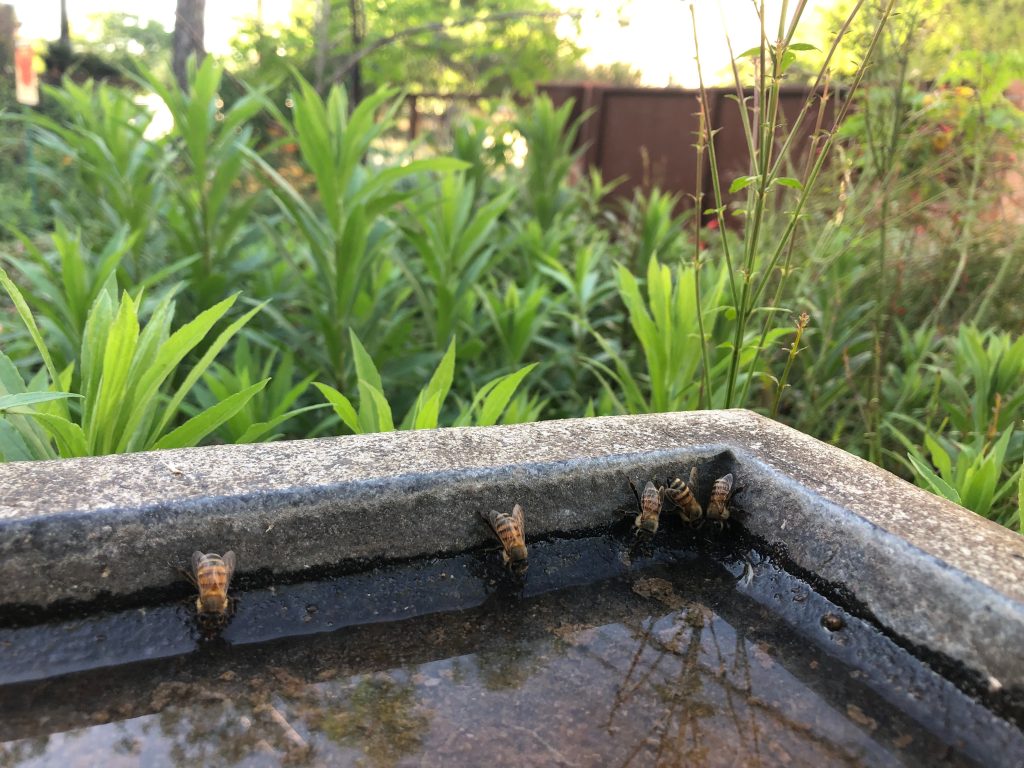
Happy hour at the bird feeder. Thirsty bees grab a sip of water. –Photo by Monika Maeckle
Liz ended up moving her hives out to the country where a friend was enjoying the tax break alloted those with a minimum five hives per acre.
In early 2023 another unexpected ice storm hit Texas. I covered my two hives with blankets and hoped for the best.
But the bees didn’t make it. The extreme cold coupled with my failure to put inner covers on the hive killed them. My bad.
I quit beekeeping.
Years later, I still miss it. The smell of the smoke, the quiet roar of a healthy hive, the flower bounty in my yard thanks to all those free ecosystem workers. I remember with fondness our hive checks during COVID. The all-female gatherings fueled me during the loneliness of the pandemic.
Three girlfriends and I would meet on the screened porch of my house sporting veils and masks. Cecile would stuff the smoker with pine needles, light a match, and as the evergreen-scented smoke wafted from the metal spout, she pumped it into the frames to calm the bees. “Hello, my lovelies,” she whispered, as one of us assisted in lifting the frames from the boxes. Oma, my 86-year-old mom who lived in the casita across the yard, would join this all-female gathering seated safely on the screened porch. She marveled at this matriarchal assembly and later, at the resulting honey harvest. As we shared beekeeping chores and stories, Oma would watch with fascination, totally immersed in the apiary show. She never got stung, but my dog Cacteye and I did.
I call myself a recovering beekeeper, which suggests an act of giving up something that was difficult to forsake. As much as I miss it, given what I’ve learned and know, I can’t justify returning to this seductive hobby.
Any other recovering beekeepers out there? Please share in the comments.
TOP PHOTO: Bees hang out on a hot summer day at my downtown pollinator garden. –Photo by Monika Maeckle
Related articles:
- Photo of South Texas Cactus Bees earns Karine Aigner Wildlife Photographer of the Year award
- BEESAT honey, anyone? San Antonio apiary program brings beehives to the airport
- Flower “bed” works overtime as overnight bachelor pad for solitary bees
And the winner is: Lemon Beebalm for 2025 Pollinator Plant of the YearBlue Curls or Beebalm? Please vote for the 2025 Pollinator Plant of the Year - Past “Unofficial” Pollinator Plants of the Year
- Lawn-and-order gardening ethos gives way to the lawnless
- San Antonio architect converts downtown parking lot into a native “prairie cloud”

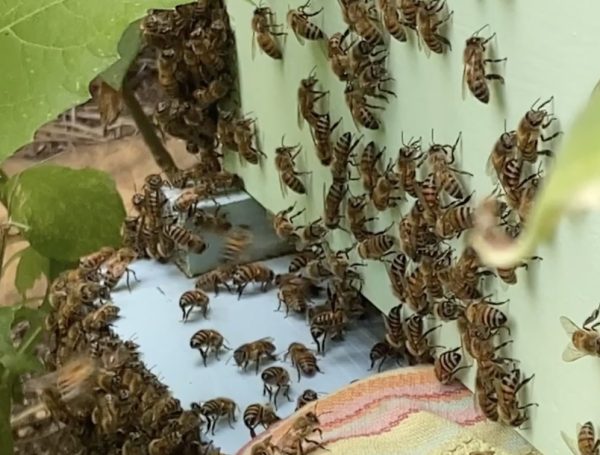
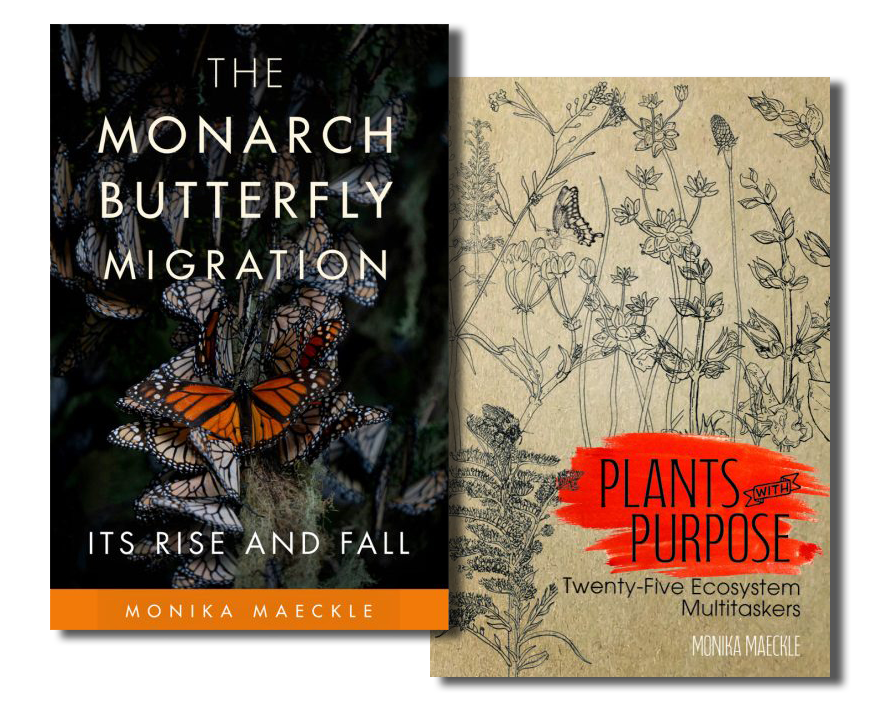
I had 20 acres in the Big Thicket Preserve in Southeast Texas. I hosted a beekeeper from Minnesota on my property. In exchange, he’d leave me a couple of starter hives. I loved collecting the honey, but I also knew that on 20 acres of biodiversity, they would easily build up enough to over winter. I quit after about 4-5 years. The boxes were too heavy for me to lift and my partner was ill. I miss the unique honey, but since the controversy about encouraging non-indigenous species, I’ve switched to blue agave.
Thank you for bringing your personal experience to the complex problem of the use of honeybees as pollinators. It is encouraging that many universities now have departments dedicated to the study of diversity and sustainability that can offer solutions to these problems. A casual google search revealed this article from Colorado State University that highlight some possible agricultural solutions and practices. https://sustainability.colostate.edu/humannature/incorporating-bees-in-agricultural-systems/
Yes, the boxes are HEAVY! Thank you for sharing, —MM
It’s fun to experience your everyday aspects of being a keep. My favorite part of this post was the hands too swollen to type or write, and the scene of smoking up near the porch to share the space with the bees. Were they inside? What was it like to corral them back into a hive? What did Cecile teach you about that? How do we roll beekeeping into sustainable levels?
Thanks for the feedback, boss! 😎
The history of beekeeping and honey is almost as old as history itself. Your article prompted me to read about it. It is most interesting.
I do not understand why you quit a hobby that you clearly enjoyed .
.
Very nice article. I like many others have thought of beekeeping as a joyous endeavor but somehow I never had time to make the effort. As you mentioned having an experienced mentor helped you bridge the knowledge gap. I did not happen to know of anyone who kept bees.
I did always try to have an assortment of flowers available for them to forage on and surprisingly my raspberry patch was always loaded from mid summer to late fall.
I found a beekeeper recently and offered him an area on my property, no strings attached if he needed a place for a couple of hives. We have still to get together to see if it would be suitable.
After reading your article it makes me wonder what would happen if the bees were left alone and let them keep their honey without robbing them of it?
Anyway, nice article. While speaking of Monarchs, I have cultivated milkweed on my property and every summer roughly in July I have had 1-2 Monarchs floating around my house. As a kid there used to be hundreds here in South Idaho. I’m not sure if they are just passing through or were born here. They are nice to see in any case.